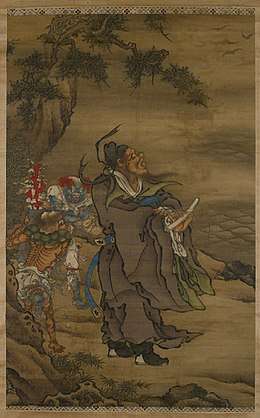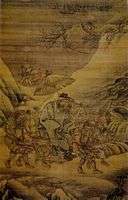Zhong Kui
Zhong Kui (Chinese: 鍾馗) is a deity in Chinese and also Japanese mythology (where his name is pronounced Shōki). Traditionally regarded as a vanquisher of ghosts and evil beings, and reputedly able to command 80,000 demons, his image is often painted on household gates as a guardian spirit, as well as in places of business where high-value goods are involved.
| Zhong Kui | |||||||||
|---|---|---|---|---|---|---|---|---|---|
 A Ming painting of Zhong Kui the Demon Queller with Five Bats, with the five bats representing the five blessings as well as the vase, red coral, and fungi—held by demons—that also contain auspicious symbolism | |||||||||
| Chinese name | |||||||||
| Traditional Chinese | 鍾馗 | ||||||||
| Simplified Chinese | 钟馗 | ||||||||
| |||||||||
| Vietnamese name | |||||||||
| Vietnamese alphabet | Chung Quỳ | ||||||||
| Korean name | |||||||||
| Hangul | 종규 | ||||||||
| Japanese name | |||||||||
| Kanji | 鍾馗 | ||||||||
| |||||||||
Becoming the king of ghosts
According to folklore, Zhong Kui travelled with a friend from his hometown, Du Ping (杜平), to take part in the state-wide imperial examinations held in the capital city. Though Zhong Kui attained great academic success through his achievement of top honours in the major exams, his rightful title of "Zhuangyuan" (top-scorer) was stripped from him by the emperor because of his disfigured and ugly appearance. In anger and fury, Zhong Kui committed suicide by continually hurling himself against the palace gates until his head was broken, whereupon Du Ping had him buried and laid to rest. During the divine judgment after his death from suicide, Yama (the Chinese Hell King) saw much potential in Zhong Kui, intelligent and smart enough to score top honours in the imperial examinations but condemned to Hell because of the grave sin of suicide. Yama then gave him a title as the king of ghosts, and tasked him to hunt, capture, take charge of and maintain discipline and order among all ghosts. After Zhong Kui became the king of ghosts in Hell, he returned to his hometown on Chinese New Year's eve. To repay Du Ping's kindness, Zhong Kui gave his younger sister in marriage to Du Ping.[1]
Popularization in later dynasties
Zhong Kui's popularity in folklore can be traced to the reign of Emperor Xuanzong of Tang China (712 to 756). According to Song Dynasty sources, once the Emperor Xuanzong was gravely ill and had a dream in which he saw two ghosts. The smaller of the ghosts stole a purse from imperial consort Yang Guifei and a flute belonging to the emperor. The larger ghost, wearing the hat of an official, captured the smaller ghost, tore out his eye and ate it. He then introduced himself as Zhong Kui. He said that he had sworn to rid the empire of evil. When the emperor awoke, he had recovered from his illness. So he commissioned the court painter Wu Daozi to produce an image of Zhong Kui to show to the officials. This was highly influential to later representations of Zhong Kui.[2][3]
Legacy
Zhong Kui and his legend became a popular theme in later Chinese painting, art, and folklore. Pictures of Zhong Kui used to be frequently hung up in households to scare away ghosts. His character was and still is especially popular in New Year pictures.[3]
In art
 Dai Jin's The Night Excursion of Zhong Kui (15th century), depicting Zhong Kui undertaking a night patrol while being carried in a sedan chair by four demons
Dai Jin's The Night Excursion of Zhong Kui (15th century), depicting Zhong Kui undertaking a night patrol while being carried in a sedan chair by four demons Wen Zhengming's Zhong Kui in a Wintry Grove (Ming dynasty), matching Ge Hong's Master Embracing Simplicity that states that ominous creatures often haunted forests, which is why Zhong Kui is needed there
Wen Zhengming's Zhong Kui in a Wintry Grove (Ming dynasty), matching Ge Hong's Master Embracing Simplicity that states that ominous creatures often haunted forests, which is why Zhong Kui is needed there Zhong Kui and Spiders by Zhou Xun (1649–1729), depicting Zhong Kui eyeing spiders dangling down from above (a rebus or auspicious pun for 'joyful things')
Zhong Kui and Spiders by Zhou Xun (1649–1729), depicting Zhong Kui eyeing spiders dangling down from above (a rebus or auspicious pun for 'joyful things') Ren Yi's Zhong Kui (1883), in which Zhong Kui appears as an elegant but somewhat eccentric scholar, with his sword sheathed and a blossom in his hair, as he decorously reads
Ren Yi's Zhong Kui (1883), in which Zhong Kui appears as an elegant but somewhat eccentric scholar, with his sword sheathed and a blossom in his hair, as he decorously reads Auspicious Omen of Abundant Peace (Qing dynasty), humorously depicting Zhong Kui being shocked as he looks at his grotesque visage in the mirror
Auspicious Omen of Abundant Peace (Qing dynasty), humorously depicting Zhong Kui being shocked as he looks at his grotesque visage in the mirror Zhong Kui is seen waving his sword at five bats representing the five blessings, as if symbolically bringing these fortunes down to someone as recipient, depicted in a late 19th or early 20th century xylograph
Zhong Kui is seen waving his sword at five bats representing the five blessings, as if symbolically bringing these fortunes down to someone as recipient, depicted in a late 19th or early 20th century xylograph Zhong Kui, the Demon Queller (17th century), in which Zhong Kui rides an ox while quelled demons carry his sword or lead his ox
Zhong Kui, the Demon Queller (17th century), in which Zhong Kui rides an ox while quelled demons carry his sword or lead his ox A 16th-century painting, depicting a seated Zhong Kui
A 16th-century painting, depicting a seated Zhong Kui A 17th-century painting by Lu Xue, depicting Zhong Kui with demons
A 17th-century painting by Lu Xue, depicting Zhong Kui with demons A painting by the Shunzhi Emperor (r. 1643–1661) of the Qing dynasty
A painting by the Shunzhi Emperor (r. 1643–1661) of the Qing dynasty A detail of Okumura Masanobu's Shōki zu (Shōki striding), dated c. 1741–1751.
A detail of Okumura Masanobu's Shōki zu (Shōki striding), dated c. 1741–1751. Fei Danxu's Zhong Kui and his Assistants Under Willows (1832), depicting Zhong Kui and his demon helpers
Fei Danxu's Zhong Kui and his Assistants Under Willows (1832), depicting Zhong Kui and his demon helpers Zhong Kui by Min Zhen (1730–after 1791), depicting Zhong Kui riding a quadrupedal creature
Zhong Kui by Min Zhen (1730–after 1791), depicting Zhong Kui riding a quadrupedal creature A 1776 painting by Min Zhen, in which Zhong Kui sits and leans on a chair
A 1776 painting by Min Zhen, in which Zhong Kui sits and leans on a chair Zhong Kui and Demons Crossing a Bridge (16th century), depicting Zhong Kui on a donkey
Zhong Kui and Demons Crossing a Bridge (16th century), depicting Zhong Kui on a donkey Zhong Kui Appreciating Plum Blossom (18th century)
Zhong Kui Appreciating Plum Blossom (18th century)
In popular culture

- Zhong Kui was venerated in Chinese folk religion by travelers fearful of encountering evil spirits.
- The Dance of Zhong Kui (跳鐘馗) developed under the Song dynasty and was adapted into opera under the Ming.
- Shōki was the namesake of the Imperial Japanese Army's single-engine Nakajima Ki-44 fighter plane.
- Zhong Kui (played by San Kuai) appears in the 1977 Bruceploitation film The Dragon Lives Again.
- Zhong Kui appears in the 1985 Taiwanese series New Legends of Chu Liuxiang
- Qiu Yun, the main character of Huang Shuqin's 1987 feminist film Woman, Demon, Human, is an opera singer famed for her portrayals of Zhong Kui.
- Zhong Kui (played by Huang Wenyong) appears in the 1987 Strange Encounters and its 1988 sequel Strange Encounters II.
- Zhong Kui (played by Law Lok Lam) appears in the 1988 Asia Television series The Chinese Ghostbuster.
- Zhong Kui appears in the Hong Kong comic Saint and, as Shōki, in the American comic Usagi Yojimbo.
- Zhong Kui is the main character in the 1994 Taiwanese–Singaporean television series Heavenly Master Zhong Kui (《天師鍾馗》, Tianshi Zhong Kui).
- Zhong Kui (played by Wu Ma) is the main character in the 1994 Hong Kong film The Chinese Ghostbuster.
- Pierre DeCelles created a Zhong Kui series of paintings in 2004.
- Zhong Kui (played by Bobby Au-yeung) is the main character of the 2009 series Ghost Catcher: Legend of Beauty.
- Zhong Kui is the main character in the 2012 Hunan Television series The Legend of Zhong Kui (《鍾馗傳說》, Zhōng Kuí Chuánshuō).
- Zhong Kui (played by Chen Kun) is the main character in the 2015 movie Zhong Kui: Snow Girl and the Dark Crystal.
- Zhong Kui "the Demon Queller" is a character from the Chinese pantheon in the 2014 Hi-Rez MOBA game Smite.
- Zhong Kui appears as a character in the 2018 novel Voice of the Elders by Greg Ripley.
- Zhong Kui appears as a DLC character in Crytek's 2018 survival game Hunt: Showdown.
See also
- Culture of the Song dynasty
- Gods and demons (shenmo) fiction
- Ghosts in Chinese culture
- Chinese numismatic charms
- Menshen, Chinese door gods
- Imperial examination in Chinese mythology
- Kui in Chinese mythology
- The Five Poisons
References
- Nagendra Kumar Singh (1997). International encyclopaedia of Buddhism: India [11]. Anmol Publications. pp. 1372–1374. ISBN 978-81-7488-156-4. Retrieved 7 June 2013.
- Richard Von Glahn (2004). The Sinister Way: The Divine and the Demonic in Chinese Religious Culture. University of California Press. pp. 122–128. ISBN 978-0-520-92877-0. Retrieved 7 June 2013.
- Dillon, Michael, ed. (1998). China: A Cultural and Historical Dictionary. London: Curzon Press. pp. 382. ISBN 0-7007-0439-6.
External links
